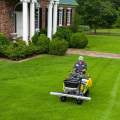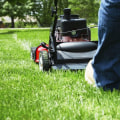Lawn maintenance refers to the ongoing care and management of a yard to ensure its health, appearance, and functionality throughout the year. It goes beyond occasional mowing and involves a comprehensive set of tasks designed to nurture grass, control weeds, manage pests, and promote overall growth. A well-maintained lawn doesn’t just enhance curb appeal—it also contributes to environmental health by improving air quality, reducing soil erosion, and providing a natural cooling effect for your property. Regular maintenance helps prevent minor issues from escalating into costly problems, whether it's patchy grass, thatch buildup, or invasive weeds taking over. A healthy lawn also creates a comfortable and inviting outdoor space for relaxation, play, or entertaining guests.
Key Components of Lawn Maintenance
At its core, lawn maintenance includes mowing, watering, fertilizing, aeration, overseeding, weed control, and pest management. Mowing is typically done weekly or bi-weekly depending on the season, and it’s important to follow the one-third rule—never cut more than one-third of the grass blade at a time to avoid stressing the plant. Watering deeply and infrequently encourages stronger root growth, and irrigation systems are often used to ensure consistency. Fertilizing replenishes nutrients that are naturally depleted over time, helping the lawn stay green and lush. Aeration, which involves perforating the soil to allow air, water, and nutrients to reach the roots, is crucial for breaking up compacted soil. Overseeding fills in bare spots and thickens the grass canopy, improving both appearance and resistance to pests and disease.
The Importance of Timing and Technique
Effective lawn maintenance isn’t just about what you do—it’s about when and how you do it. Different seasons require different care strategies. In the spring and fall, lawns benefit from more intensive treatments like fertilization and aeration. Summer calls for vigilant watering and mowing practices to help grass endure heat and drought stress. Proper technique also matters; for example, alternating mowing patterns helps prevent soil compaction and grass wear in specific areas. Overuse of fertilizers or herbicides can damage the lawn and harm surrounding ecosystems, so applying products based on soil testing and expert recommendations is best. Consistency, precision, and seasonal awareness are all key to long-term lawn health.
Lawn Maintenance for Different Types of Grass
Not all lawns are created equal, and lawn maintenance must be tailored to the type of grass on your property. Cool-season grasses like fescue and Kentucky bluegrass thrive in northern climates and require different care schedules than warm-season grasses like Bermuda or Zoysia, which grow best in southern regions. Each grass type has unique watering, mowing, and fertilizing needs, and understanding these nuances helps avoid common pitfalls. Additionally, shaded areas, slopes, and high-traffic zones might need special attention to prevent thinning and soil erosion. A professional lawn care provider will assess these variables to create a customized plan that delivers consistent results.
Beyond the Grass: Integrating Landscaping and Lawn Care
Lawn maintenance often intersects with other aspects of outdoor care, especially when hardscaping, flower beds, and trees are involved. Managing the edges where turf meets concrete, gravel, or mulch keeps the entire yard looking clean and intentional. Proper drainage, soil grading, and even the condition of driveways and patios play a role in the overall success of lawn maintenance efforts. Companies like Concrete Commandos Friendswood exemplify how integrating concrete services with lawn care can elevate the entire property by ensuring structural integrity and aesthetic balance. Whether it’s edging along a walkway or ensuring water runoff doesn’t pool in the yard, hardscape and softscape maintenance must work hand in hand.
Why Lawn Maintenance Matters Long-Term
Regular lawn maintenance is more than just a cosmetic upgrade—it’s an investment in your property’s value and your quality of life. A well-cared-for lawn provides a space where families gather, children play, and homeowners take pride in their surroundings. It also reduces allergens, deters pests, and promotes biodiversity. By staying on top of maintenance year-round, you avoid costly restorations and ensure your outdoor space remains vibrant and healthy. Whether you handle it yourself or hire professionals, committing to a consistent lawn care routine is the foundation of a beautiful, thriving yard that enhances your home and reflects your commitment to responsible property care.






